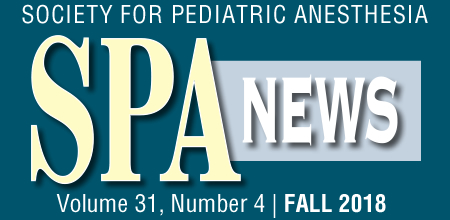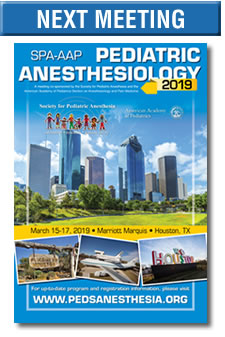meeting reviews
Session IV: PEDx Talks. Less But Better. Part 1
By Elizabeth S. Yun, MD
On Friday, October 12, 2018 the Society for Pediatric Anesthesia held its Annual Meeting in San Francisco, CA. At this meeting the SPA debuted a new format for the afternoon session. Based on the Ted Talk format, the PEDx Talks consisted of eight 15-minute lectures. This article will briefly review four of these lectures.
Remigio A. Roque MD, Pediatric Anesthesia Fellow at Seattle Children’s Hospital, gave the first lecture, Caring for the Transgender Patient. He began with some important definitions. Transgender is defined as one’s gender identity not matching the sex assigned at birth and is not the same as anatomic sex or sexual orientation. Gender identity is a known sense of how one identifies oneself, an inner quality that is not determined by external features and is expressed by various forms like clothes, patterns of speech, etc.
As he noted, transgender people are now becoming more visible with the recent rise of the transgender rights and equality movements. Therefore, anesthesiologists need to familiarize themselves with the issues facing this population. People in this group face issues around harassment, bullying, assault, and strained family relationships. This population is also at risk for mental health issues including very high rates of depression, anxiety, body image issues, self harm, substance abuse and suicide. To help and support young people in these situations, the American Academy of Pediatrics takes a gender affirming-approach that the patient controls.
Strategies for this approach initially include a gender transition that allows the child to live more authentically by picking a new name and pronouns and using gender-aligned bathrooms. At puberty, strategies may focus on reversible medical interventions, such hormone drugs that stop puberty. They may then progress to gender-affirming medications, like testosterone, estrogen and surgical options. These strategies are irreversible and therefore used on adults and older adolescents. This transition is successful when there is great support from family, community, and mental health providers. Anesthesiologists can help this transition in many positive ways. One of the most important things to do is use the patient's chosen name and their preferred pronouns. The caveat is only if use of these chosen names or pronouns puts them in an unsafe situation. Preoperative interactions should only focus on pertinent medical issues. Pregnancy tests need to be tailored to the patient’s actual body. Performing a physical exam or simple physical acts like placing monitors should be performed with sensitivity to the patient’s needs and anxieties. Even these simple measures have great impact for these patients.
The second lecture, Gene therapy, Nnusinersen, and Other Designer Therapies: a Primer for the Anesthesiologist was given by RJ Ramamurthi, MD (Stanford University). Genetic diseases affect 10 percent of populations and 80 percent of them are due to chromosome issues. He focused on spinal muscular atrophy, an autosomal recessive inherited disease that occurs from the lack of the survival motor neuron protein (SMN) 1 protein that is involved with the health of the motor neuron.
The defect occurs on chromosome 5 and leads to a lack of SMN 1 protein production leading to the muscle weakness throughout the body. The long arm of this chromosome also has the locus for another protein, SMN 2 that also provides a similar function as SMN 1. SMN2 usually undergoes an alternate splicing that leads to a non-functional protein although some transcriptions of SMN 2 can produce a functional SMN protein. Therefore, the presence of a functional SMN2 protein can affect the phenotype of the spinal muscular atrophy of the patient.
Based on this work, gene modification therapies have been researched to find a potential treatment for these patients. One strategy is gene therapy where an adenovirus vector delivers a new gene to cells that improves transcription of the SMN protein. Another strategy is to use antisense oligonucleotides, such as nusinersen (Spinraza), to silence the alternate splicing of SMN2 so that SMN2 produces functional SMN proteins. This drug is given intrathecally and has a long half-life of several months. Several phase 3 studies, ENDEAR on SMA1 and CHERISH on SMA2 and 3, ended early because of the great response of SMA patients. These studies have showed significant improvement in motor function, a greater proportion of motor milestone improvement, and a decrease in mortality for these patients.
The third lecture, Physician Suicide, was given Anne Glowinski, MD, MPE, Professor of Psychiatry at St. Louis Children’s Hospital/Washington University. In her research, she discovered the impact of stigma around mental health issues in the medical profession. However, there is a great deal of alarming data on burnout and mental health issues among physicians. There is a high rate of suicides in medical school, with male physicians more at risk for suicide compared to the general population. The data is worse for female physicians, with twice the rate compared to the general population. Physicians also have a higher rate of suicide completion, with overdosing as the most common method compared to the general population. People do not enter medical school more neurotic (i.e. higher risk of anxiety and depression under stress) but the rates of depression grow during medical school and residency.
Recently, the ACGME mandated that every specialty needed to take care of mental health problems because of alarming data on physician burnout. However, the culture in the medical field has not changed. The physician culture stigmatizes seeking help for depression and burnout despite evidence demonstrating that treating the depression is actually extremely effective. The internalization of stigma happens early in medical school where people receive the message that seeking treatment for mental health issues is a sign of weakness. Physicians are supposed to be resilient without needing any help. However, behaving as if one is resilient is not the same being resilient. While emotions need to be controlled during acute situations, there needs to be an opportunity to debrief and manage these strong emotions. The stigma of shame at having one’s identity intertwined with mental health problems needs to be confronted in the medical profession.
Jeffrey J. Illiff, PhD (Oregon Health Sciences University) presented the lecture Sleep and the Human Brain. While much is known about the effects of sleep deprivation on functions like memory formation and retention, very little is known about what happens in the brain during sleep. He discussed CSF sink hypothesis to describe how the brain handles the lack of a lymphatic system. CSF in the interstitial spaces carry away waste product filtered from the blood in the brain at the choroid plexus.
The CSF serves as a sink for the interstitial proteins that can’t cross the blood brain barrier. This process helps the brain maintain interstitial protein homeostasis. Over the last several years, this theory has been reconsidered, and this affects how we think about sleep and pathogens and neurological diseases. There is now research challenging the sink hypothesis, and examining new ways the brain has repurposed the blood vasculature that provides nutrients and to organize the exchange of interstitial fluid and CSF to maintain interstitial protein homeostasis in the CNS.
Another aspect of this research is the realization that this process is not uniform during the day. Animal studies have shown that when the animal is asleep, there is an increase in CSF flow throughout the interstitial space. These findings suggest that when awake, metabolites accumulate in the brain. During the sleep phase, the increase in CSF flow helps the brain excrete these waste products. Therefore, lack of sleep disrupts this clearing process, allowing harmful products to accumulate and can lead to long-term consequences to the health of the brain.






